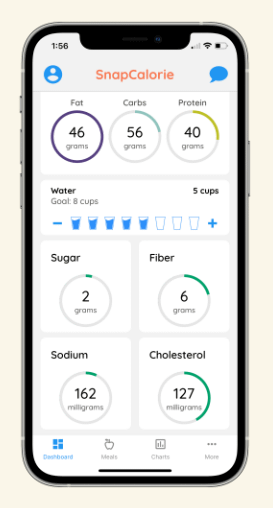Share This


Pages on this site may contain affiliate links, meaning if you book or buy something, I may earn an affiliate commission at no additional cost to you. Thank you for your support! Learn More
Also note: While I am a certified nutrition coach, I am not a medical doctor. Information here is not intended to be a replacement for the advice you should seek from your doctor.
Did you know that macro counting is an incredible tool that can assist your weight loss journey? In this 7-step guide, you will learn everything you need to know about counting macros for weight loss. Plus, you will discover my favorite macro-tracking app, with revolutionary technology to log your macros (and calories) simply by taking photos of your food!
If you are not familiar with what macronutrients are, and why keeping track of them could help you lose or maintain weight, I am here for you! Follow my 7-step guide and try to gradually put them into practice to improve your relationship with food and be able to keep your weight in check effectively and effortlessly.
The thing I love the most about counting macros is that once you keep track of them for a couple of weeks and have a rough idea about what your macro split is, you will quickly learn how to “guesstimate” the amount of each macronutrient in the foods you eat without the need of checking online or using an app!
In the next few paragraphs, we will take a deep dive into the world of macronutrients and learn the most effective ways to count them without turning the whole process into an obsession. The underlying idea is that macro counting is just one of the many instruments you can have in your toolkit, and being curious and willing to experiment is key when embarking on your health journey! So, let’s start by exploring what macronutrients are, and what is a macro split!
What Are Macronutrients?
To put it simply, macronutrients are the essential nutrients that our bodies require in relatively large quantities -especially if compared to micronutrients- to function properly and maintain overall health. They are the major sources of energy and provide the building blocks necessary for growth, repair, and maintaining various bodily functions.


Three are the main types of macronutrients:
- Carbohydrates: carbohydrates are the primary source of energy for the body. When consumed, they are broken down into glucose (sugar) and used by the cells for energy. Carbohydrates can be further classified into two categories. The first one is simple carbohydrates (sugars) found in fruits, honey, and table sugar. The second one is complex carbohydrates (starches and fiber) found in whole foods like grains, legumes, and vegetables.
- Proteins: proteins are the real building blocks of our body. As such, they are essential for the growth, repair, and maintenance of tissues. Proteins are composed of specific sequences of 20 amino acids. Some of these are directly synthesized by our organisms, while others must be obtained from our diet. Good sources of protein include meat, poultry, fish, eggs, dairy products, legumes, nuts, and seeds.
- Fats: Fats are also a significant source of energy and are essential for various bodily functions. Among these are the absorption of fat-soluble vitamins (A, D, E, and K) and the production of hormones. Fats are further classified into saturated fats (found in animal products and some tropical oils), unsaturated fats (found in plant-based oils, nuts, and seeds), and trans fats (artificially produced through hydrogenation and found in some processed foods).
How Many Calories Are in Each Macronutrient?
Another key thing to keep in mind when learning how to track macros for weight loss is that each of them provides a certain number of calories per gram.
More specifically they contain:
- Carbohydrates: 4 calories per gram
- Proteins: 4 calories per gram
- Fats: 9 calories per gram
To sum it up, each food we consume contains a specific amount of each macronutrient. While some are higher in carbs and contain little to no proteins, such as bread or pasta, others are richer in proteins and lower in carbs, such as fish or eggs. In addition, by multiplying the grams amount of each macronutrient contained in a specific food for its relative caloric power, you can easily calculate the total calories contained in that food!
Therefore, balancing the intake of these macronutrients -and that of micronutrients, i.e. vitamins, and certain minerals, as well as fiber- is important for maintaining a healthy and well-rounded diet. The specific ratio of macronutrients may vary depending on individual needs, goals, and lifestyles, and is commonly referred to as macro split.
Let’s learn how to calculate it and how it differs between different individuals.
What is a Macro Split and How to Quickly Calculate It?
A macro split, also known as a macronutrient split or ratio, refers to the distribution of macronutrients (carbohydrates, proteins, and fats) in a person’s diet. In other words, it represents the percentage or grams of each macronutrient consumed relative to the total daily calorie intake.
Knowing your rough macro split is key if you want to better tailor your diet to specific health goals, such as weight loss or maintenance, muscle gain, or athletic performance. For instance, athletes might need more carbohydrates to support their activity levels, while those on a low-carb diet may emphasize higher fat and moderate protein intake.
To quickly calculate your macro split, you can follow these steps:
- Determine your Total Daily Energy Expenditure (TDEE). The TDEE represents the total number of calories your body needs to maintain its current weight. It is based on factors like age, gender, weight, height, and activity level.
- Set your goal. Decide whether you want to lose weight, gain muscle, or maintain your current weight. Then calculate how many calories you should eat to achieve this goal. In addition, each goal will have different macronutrient recommendations.
- Choose your macro split percentages. Depending on your goal and personal preferences, you can select the percentage of calories you want to allocate to each macronutrient. Here are some common macro splits:
Weight loss: 40-50% carbohydrates, 25-35% protein, 20-30% fats
Muscle gain: 40-50% carbohydrates, 25-35% protein, 20-30% fats
Maintenance: 40-50% carbohydrates, 25-35% protein, 25-35% fats
Low-carb: 10-30% carbohydrates, 40-50% protein, 30-40% fats (keto-style diets) - Calculate grams of each macronutrient. To do that, you can either multiply the chosen percentage by your daily calorie intake. Then divide by 4 (calories per gram of carbohydrates/proteins) or 9 (calories per gram of fats). Alternatively, you can use a macro-tracking app, as the one I will present to you in a while.
For example, assuming that you lose weight at 1800 calories, you would aim to consume approximately 180 grams of carbohydrates, 135 grams of protein, and 60 grams of fats per day.
❤️❤️ Don’t miss a recipe or post! Make sure you remember to sign up for my Newsletter and follow me on social ❤️❤️!
Get Your Free Stuff!
Counting Macros For Weight Loss vs Calories: Why Should You Learn How to Track Macronutrients for Weight Loss?
As hinted previously, the primary factor for losing weight is creating a caloric deficit. This means consuming fewer calories than your body expends. Once you have set your calorie goal, tracking macros might massively help you obtain your weight loss goals. And, according to my personal experience, this might be even better than counting the calories of each food you are consuming.
The main difference is that, while counting calories focuses solely on the total energy intake, counting macros adds an extra layer of attention to the distribution of proteins, carbohydrates, and fats.
In particular, learning how to track macronutrients for weight loss can be advantageous for several reasons:
- Personalized Approach. Counting macros allows you to design a diet that suits your body’s requirements, activity level, and weight loss objectives.
- Optimal Fat Loss and Muscle Preservation. Tracking macros ensure that you consume an appropriate amount of protein. This is essential for preserving lean muscle mass during weight loss.
- Improved Dietary Choices: When you track macros, you become more mindful of the nutritional content of the foods you eat. You are more likely to opt for nutrient-dense foods, including fruits, vegetables, whole grains, and lean protein sources. Overall, this might contribute to weight loss and overall health.
- Sustainable and Flexible: Counting macros provides a flexible approach to weight loss. It doesn’t restrict specific foods or food groups, giving you more freedom and reducing the risk of feeling deprived. In turn, this flexibility makes it easier to adhere to a weight loss plan in the long run.
- Better Understanding of Your Diet: By tracking macros, you gain a deeper understanding of the nutritional composition of various foods. This knowledge can help you make informed choices and develop healthier eating habits even beyond your weight loss journey.
Of course, this comes down to my personal experience. You might find it easier to focus on calories rather than macros. In addition, it’s important to note that counting both calories and macros may not be suitable for everyone, especially if you have a history of disordered eating. Therefore, my suggestion is to find a weight loss method that aligns with your weight loss goals, promotes a positive relationship with food, and supports your overall well-being.
A 7-step Guide to Counting Macros for Weight Loss
As explained above, counting macros for weight loss can be an effective approach to help you achieve your goals.


Here’s a 7-step guide to get you started and sum up what was explained before:
Step 1: Calculate Your Caloric Needs
Determine your Total Daily Energy Expenditure (TDEE). This represents the total number of calories your body needs to maintain its current weight. You can find TDEE calculators online that consider factors like age, gender, weight, height, and activity level, or use an app, like the one I will show you later.
Step 2: Set a Caloric Deficit
To lose weight, create a calorie deficit by consuming fewer calories than your TDEE. A moderate deficit of about 250-500 calories per day is generally safe and sustainable for most people.
Step 3: Choose Your Macro Split
Select a macro split that aligns with your weight loss goals and personal preferences. A common starting point for weight loss is 40% carbohydrates, 30% protein, and 30% fats. However, these percentages can be adjusted based on your individual needs and lifestyle.
Step 4: Calculate Macro Goals
Using your chosen macro split and daily calorie target, calculate the grams of each macronutrient you should consume:
- Carbohydrates: Multiply the carb percentage by your daily calorie target, then divide by 4 (calories per gram of carbs).
- Proteins: Multiply the protein percentage by your daily calorie target, then divide by 4 (calories per gram of protein).
- Fats: Multiply the fat percentage by your daily calorie target, then divide by 9 (calories per gram of fat).
Step 5: Track Your Macros
Use a food tracking app or a food diary to record everything you eat and drink. Many apps allow you to input the foods you consume, and they will automatically calculate the macronutrient breakdown for you. This is certainly the easiest way to go about it!
Step 6: Be Mindful of Portion Sizes
While tracking macros, pay attention to portion sizes to ensure accuracy in your daily intake. Invest in a food scale and/or measuring cups to help you portion your meals correctly, at least at the beginning. This way, you will have a better gauge of what your portions should look like and, eventually, learn how to guesstimate them without the need of measuring every food you eat.
Step 7: Stay Consistent and Monitor Progress
Consistency is crucial for success. Stick to your daily macro targets, and over time, monitor your progress. This way you will be able to see how your body responds to the changes. Adjust your macros as needed to continue making progress towards your weight loss goals.
Now that you know everything about counting macros for weight loss, I want to present you with a tool that is massively helping me stay on track with my diet and obtain my health goals: SnapCalorie!
My Favorite Macro-Tracking App: SnapCalorie!
Tracking your food might be quite a boring and demanding task, especially if you have a busy schedule or don’t have the skills to do it. Luckily, there are a lot of tools out there that can massively help you with macro-tracking and attaining your weight loss goals. Among them, my favorite is definitely SnapCalorie, available both on website and app versions!


Snapcalorie is truly your “Personal Nutrition Assistant”. Its advanced AI algorithm analyzes the foods you log in to and provides personalized nutrition insights tailored to your dietary preferences and goals, as well as your unique nutritional needs, such as age, gender, activity level, and health conditions. Whether you’re aiming for weight loss, muscle gain, or simply maintaining a balanced diet, this powerful AI nutritionist offers valuable recommendations to help you make more informed food choices.
But the thing I love the most about this incredible app is the new photo-logging feature. This allows you to track your meals by simply taking a photo: the AI technology will identify and log the items automatically. Plus, this is a great way to have a visual record of what you have eaten day by day. No more typing is required!
Whether you decide to track your macros or calories, I genuinely recommend checking out SnapCalorie. If you decide to give it a try, don’t hesitate to use my affiliate code “caitlincooking” at checkout for a 25% discount off the current list price!
If you have found this article insightful, don’t hesitate to share it with your family and friends! And consider reading My MAGIC FORMULA for Weight Loss: lose weight easier in 2023! for further information on how to lose weight effectively and sustainably! 💗
Please remember to consult with a registered dietitian or nutritionist to obtain personalized recommendations, especially if you have any health concerns or you need more specific nutritional advice.











